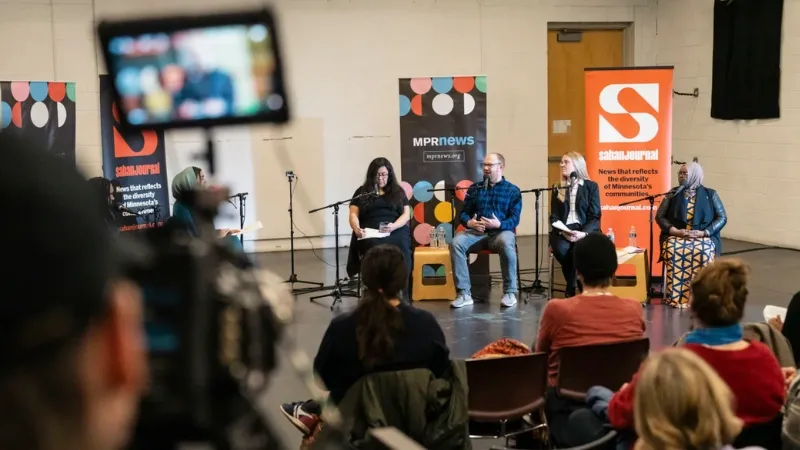News
Four Public Media x Hyperlocal Partnerships to Watch—And Back
September 5, 2025

These examples show the value of supporting partnerships between public media and hyperlocal outlets
Hyperlocal newsrooms are used to stretching every dollar, every hour, and every reporter. Public media outlets, too, are being pushed to their financial limits. The recent elimination of $1.1 billion in federal funding for the Corporation for Public Broadcasting has left more than 1,500 locally owned stations scrambling to fill gaps in their budgets. At least 115 stations are losing more than 30 percent of their budgets—putting rural, Indigenous, and underserved communities at greatest risk of losing reliable local news and educational programming, according to the MacArthur Foundation.
Philanthropy has stepped in with emergency relief, including a $36.5 million Public Media Bridge Fund and the MacArthur Foundation, but one-time infusions are not a long-term solution. The real opportunity for funders lies in fostering sustainable partnerships between hyperlocal outlets and public media organizations.
As Pivot Fund CEO Tracie Powell wrote in Current, public media can be viewed not just as broadcasters, but as civic infrastructure. That shift unlocks a powerful vision: public media providing reach and infrastructure, while hyperlocal newsrooms bring lived experience, cultural knowledge, and trust. Together, they create an ecosystem of community-centered journalism that is far more resilient—and far more impactful.
Partnership Models to Watch
285 South + WABE (Atlanta)
285 South, a newsroom covering immigrant and refugee communities in Metro Atlanta, partnered with WABE, Atlanta’s NPR/PBS affiliate, to expand coverage and reach. What began as an informal interview turned into a formal content-sharing agreement: each newsroom can republish up to three digital stories per week from the other.
For WABE Managing Editor Alex Helmick, the collaboration expands capacity:
“Partnerships provide opportunities to tell stories that you simply can’t tell because you just don’t have the resources to do it, but you’re telling the stories that your audience deserves. You can’t parachute in and tell community stories that resonate, so collaborating with smaller outlets also helps fill that gap.”
For 285 South founder Sophia Qureshi, the partnership is about visibility and sustainability:
“There’s so much happening, especially in the immigrant community space, and there’s just not enough people covering it. The only way to manage this moment is to work together as much as possible. Rather than seeing each other as competitors, we see each other as collaborators.”
Sahan Journal + Minnesota Public Radio (Minnesota)
In Minnesota, Sahan Journal’s early-stage partnership with Minnesota Public Radio included salary support for its founding editor, office space through MPR’s Glen Nelson Center, mentorship, and content-sharing opportunities. That investment paid off: today, Sahan is a $3 million newsroom with more than 20 staff, delivering essential coverage of immigrant and communities of color across the state.
El Tímpano + KQED (Bay Area, CA)
El Tímpano, a bilingual newsroom serving Latino and immigrant communities in Oakland, collaborates with KQED, the Bay Area’s NPR/PBS affiliate, on co-reporting projects and shared coverage of issues such as housing, immigration, and local governance. El Tímpano contributes cultural expertise and trusted community relationships; KQED amplifies reach across the region.
Documented + WNYC (New York City, NY)
Documented, which covers immigrant communities in New York City, collaborated with WNYC on stories amplifying immigrant issues soon after its launch. The collaboration elevated Documented’s deeply sourced reporting while bringing immigrant voices to one of the country’s largest public radio audiences.
Together, these examples show that partnerships aren’t anomalies—they represent a growing movement across the country.
Why Funders Should Care
- Efficiency and Reach
Partnerships make limited resources go further by avoiding duplication and leveraging each organization’s strengths. Hyperlocals bring cultural knowledge and sourcing. Public media brings reach, brand recognition, and distribution infrastructure. - Equity and Representation
These collaborations expand coverage into communities that have historically been overlooked or misrepresented. For funders, investing in partnerships ensures dollars reach audiences who need information most. - Sustainability
Beyond content sharing, deeper partnerships—co-investments in staff, joint fundraising, shared technology, and training—create stability for both partners. This shifts funding from emergency stopgaps to systemic solutions. - Public Value
At a moment when public trust in media is fragile, these partnerships demonstrate what community-centered journalism looks like. They give audiences tangible reasons to support, listen to, and trust local news.
The Way Forward
Hyperlocal outlets bring lived expertise, and public media brings infrastructure. Alone, neither has enough resources to meet communities’ information needs at this precarious moment. Together, they represent a sustainable path forward for local news ecosystems.
As Powell argued in Current:
“Public media must evolve from broadcaster to backbone—becoming the infrastructure that supports, connects, and amplifies the work of hyperlocal outlets.”
Funders have a chance to accelerate this shift. Supporting partnerships between hyperlocal publishers and public media outlets doesn’t just strengthen journalism—it strengthens democracy, community resilience, and civic trust.